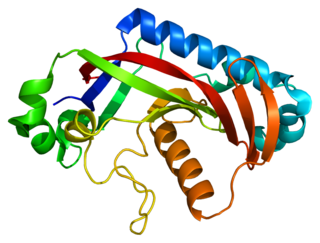Myelin transcription factor 1 is a protein that in humans is encoded by the MYT1 gene. [5] [6] [7]
Myelin transcription factor 1 is a protein that in humans is encoded by the MYT1 gene. [5] [6] [7]
The protein encoded by this gene is a member of a family of neural specific, zinc finger-containing DNA-binding proteins. The protein binds to the promoter regions of proteolipid proteins of the central nervous system and plays a role in the developing nervous system. [7]
Click on genes, proteins and metabolites below to visit related articles. [§ 1]

A zinc finger is a small protein structural motif that is characterized by the coordination of one or more zinc ions (Zn2+) which stabilizes the fold. It was originally coined to describe the finger-like appearance of a hypothesized structure from the African clawed frog (Xenopus laevis) transcription factor IIIA. However, it has been found to encompass a wide variety of differing protein structures in eukaryotic cells. Xenopus laevis TFIIIA was originally demonstrated to contain zinc and require the metal for function in 1983, the first such reported zinc requirement for a gene regulatory protein followed soon thereafter by the Krüppel factor in Drosophila. It often appears as a metal-binding domain in multi-domain proteins.

EGR-1 also known as ZNF268 or NGFI-A is a protein that in humans is encoded by the EGR1 gene.

Runt-related transcription factor 2 (RUNX2) also known as core-binding factor subunit alpha-1 (CBF-alpha-1) is a protein that in humans is encoded by the RUNX2 gene. RUNX2 is a key transcription factor associated with osteoblast differentiation.

Proteolipid protein 1 (PLP1) is a form of myelin proteolipid protein (PLP). Mutations in PLP1 are associated with Pelizaeus–Merzbacher disease. It is a 4 transmembrane domain protein which is proposed to bind other copies of itself on the extracellular side of the membrane. In a myelin sheath, as the layers of myelin wraps come together, PLP will bind itself and tightly hold the cellular membranes together.

DNA replication licensing factor MCM2 is a protein that in humans is encoded by the MCM2 gene.

M-phase inducer phosphatase 2 is an enzyme that in humans is encoded by the CDC25B gene.

WEE1 homolog , also known as WEE1, is a protein which in humans is encoded by the WEE1 gene.

Protein C-ETS2 is a protein that in humans is encoded by the ETS2 gene. The protein encoded by this gene belongs to the ETS family of transcription factors.

M-phase inducer phosphatase 3 is an enzyme that in humans is encoded by the CDC25C gene.

Membrane-associated tyrosine- and threonine-specific cdc2-inhibitory kinase also known as Myt1 kinase is an enzyme that in humans is encoded by the PKMYT1 gene.

Nuclear factor 1 X-type is a protein that in humans is encoded by the NFIX gene. NFI-X3, a splice variant of NFIX, regulates Glial fibrillary acidic protein and YKL-40 in astrocytes.

Zinc finger protein 238 is a zinc finger containing transcription factor that in humans is encoded by the ZNF238 gene.

E3 ubiquitin-protein ligase TRIM33, also known as (ectodermin homolog and tripartite motif-containing 33) is a protein encoded in the human by the gene TRIM33, a member of the tripartite motif family.

Transcription factor HIVEP3 is a protein that in humans is encoded by the HIVEP3 gene.

Zinc finger protein 7 is a protein that in humans is encoded by the ZNF7 gene.

Zinc finger protein 423 is a protein that in humans is encoded by the ZNF423 gene.

2′,3′-Cyclic-nucleotide 3'-phosphodiesterase is an enzyme that in humans is encoded by the CNP gene.

Homeobox protein Nkx-6.2 is a protein that in humans is encoded by the NKX6-2 gene.

Myelin regulatory factor, also known as myelin gene regulatory factor (MRF), is a protein that in humans is encoded by the MYRF gene.

ZNF839 or zinc finger protein 839 is a protein which in humans is encoded by the ZNF839 gene. It is located on the long arm of chromosome 14. Zinc finger protein 839 is speculated to pay a role in humoral immune response to cancer as a renal carcinoma antigen (NY-REN-50). This is because NY-REN-50 was found to be over expressed in cancer patients, especially those with renal carcinoma. Zinc finger protein 839 also plays a role in transcription regulation by metal-ion binding since it binds to DNA via C2H2-type zinc finger repeats.
This article incorporates text from the United States National Library of Medicine, which is in the public domain.